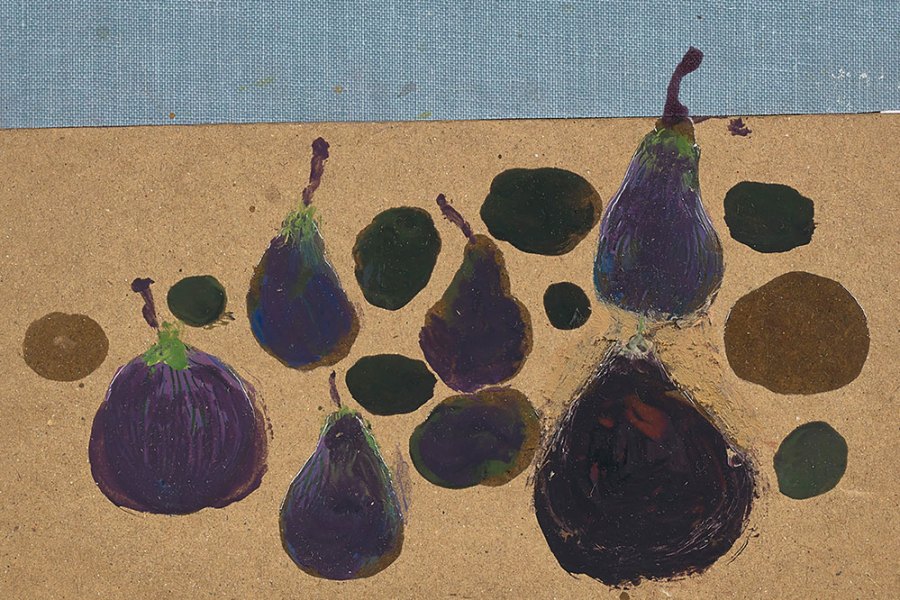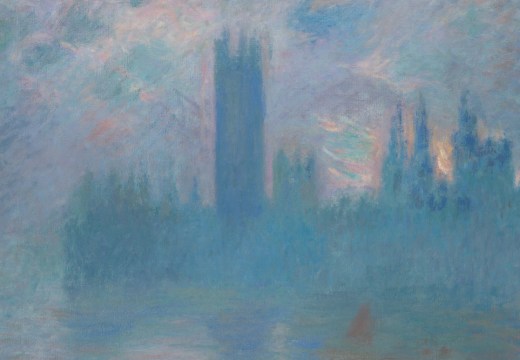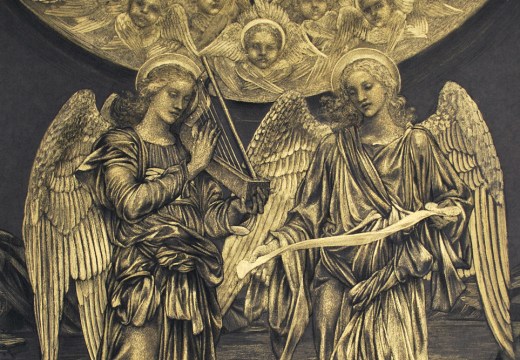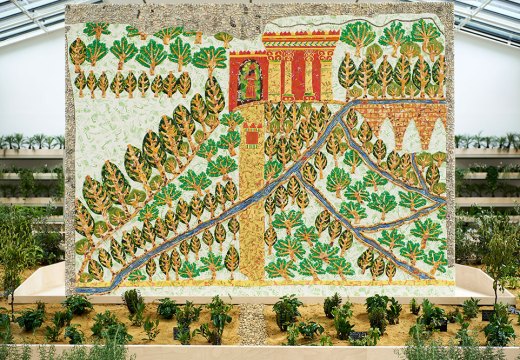On a residency in Germany some years ago, Andrew Cranston came unstuck. Short of canvases and cardboard, the Scottish painter was unable to find anything suitable on which to paint – until he happened upon a second-hand bookshop. There he found an assortment of cheap, linen-covered books, each with two surfaces perfect for his signature combinations of distemper, oil and varnish. In ‘Never a joiner’, an exhibition of Cranston’s work at Ingleby Gallery in Edinburgh, these small and delicate works are front of house. Some still have their spines or pre-existing cover illustrations visible: they are, in the words of gallerist Richard Ingleby, ‘story-telling paintings’.
In The proper way to paint figs, we see how this material has become an integral part of Cranston’s craft. The figs themselves are antithetically emphasised by what Cranston calls ‘an Alpinised version’ of Ruberslaw, a hill near his birthplace of Hawick in the Scottish borders, which ‘all local schoolchildren learn was once volcanic’. The fruit ‘look a bit like pears and a bit like aubergines’, he writes in the catalogue, but they have a volcanic quality too, bulging with potential and threatening the integrity of the landscape above.

The proper way to paint figs (2023), Andrew Cranston. Photo: John McKenzie; courtesy the artist and Ingleby, Edinburgh
‘Never a joiner’ includes 14 of Cranston’s most recent works, each completed this year. His work has found a natural home at Ingleby, a private gallery that relocated five years ago to the former Glasite Meeting House in Edinburgh’s new town, and which exhibited the work of his partner, Lorna Robertson, last summer. The title is an accurate depiction of Cranston’s individual spirit, diverse influences and refusal to be classified. But it has a touch of deception too. As the show make clear, Cranston is forever joining together memories, joining the past with the present and joining his work to the artistry that came before him.

Walled garden (after Paul Klee) (2023), Andrew Cranston. Photo: John McKenzie; courtesy the artist and Ingleby, Edinburgh
Walled garden (after Paul Klee) is typical of this approach, its background forming a wall to contain its chaotic action of pots, animals and plants. A doorway to the outside world is faint and insignificant on first inspection, but then reveals itself as intricately latticed, enticing us to consider how enclosure can help the artist’s imagination to flourish. Aberdeen studio (my blue period) is Cranston’s most autobiographical work, a depiction of a former workplace which, thanks to high rents in the oil capital, was also where he lived. He stopped short of painting his makeshift bed, but subtly hints at this hybrid domesticity through his paint brushes in a tin of baked beans, gently juxtaposed with a saucepan containing the tin’s former contents. A few splodged snails on a flat surface remind us that conceptual connections are as important as real memories in Cranston’s paintings. In a smaller space, these crowded canvases and surreal elements imposed upon mundanity could feel rather claustrophobic. But Ingleby’s vast, high-ceilinged downstairs gallery gives us room to view these paintings from near and afar and gives competing layers the space to expand towards us.

Aberdeen studio (my blue period) (2023), Andrew Cranston. Photo: John McKenzie; courtesy the artist and Ingleby, Edinburgh
The catalogue is a curious beast, focusing on the book covers and including many works not included in the exhibition display, while leaving out most of the big paintings. In his text, compiled from ‘scraps of paper, index cards and jotters that kick around my studio floor,’ Cranston refers to Charlotte Salomon as well as the poets Elizabeth Bishop and W.S. Graham. Salomon’s influence can be felt throughout the show and in Cranston’s haphazard writing: his sometimes confusing narratives seek not only to explain, but to thrill too.

A snake came to my coffee table on a hot, hot night (2023), Andrew Cranston. Photo: John McKenzie; courtesy the artist and Ingleby, Edinburgh
The book features a work titled A snake came to my coffee table on a hot, hot day to drink there, which Cranston describes as a depiction ‘of our old flat, except there is a snake in it’. On the dark and rather chilly staircase at Ingleby, we find instead A snake came to my coffee table on a hot, hot night. The former shows a cluttered interior typical of Cranston’s work; the latter scene is stripped back of all humanity, the snake the only sign of life in an austere Munch-like setting, overlooking a blue-grey landscape. Rather than an absurd addition to a domestic scene, the snake is suddenly in control, reminding us of the power of a change as natural as day and night.
Cranston’s show is part of the Edinburgh Art Festival, which faces the annual challenge of combining major retrospectives – Grayson Perry and Peter Howson this year – with riskier commissions, like Lindsey Mendick’s ‘confessional’ ceramics installation, ‘SH*TFACED’, at Jupiter Artland and Sean Burns’s film Dorothy Towers, which tells a compelling story of two Birmingham residential blocks which became a haven for the city’s LGBT communities. At the private but long-established Ingleby Gallery, ‘Never a Joiner’ does a good job of bridging the gap, showing a small body of work that sees a bigger picture and exposing the duplicity of its title along the way.
‘Andrew Cranston: Never a Joiner’ is at Ingleby Gallery, Edinburgh until 16 September.
Unlimited access from just $16 every 3 months
Subscribe to get unlimited and exclusive access to the top art stories, interviews and exhibition reviews.














![Masterpiece [Re]discovery 2022. Photo: Ben Fisher Photography, courtesy of Masterpiece London](http://www.apollo-magazine.com/wp-content/uploads/2022/07/MPL2022_4263.jpg)
It’s time for the government of London to return to its rightful home